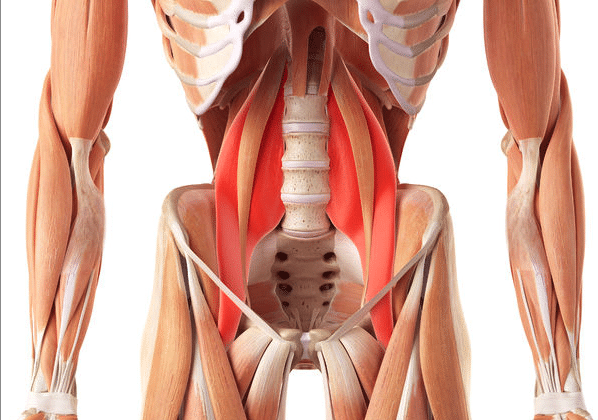What Does Psoas Release Feel Like? – What Most People Experience
The psoas muscle is the most powerful hip flexor muscle, and is essential to stability of the hips, pelvis, and spine. It is commonly found to be short and tight on testing (the Thomas Test), but not always.
Just because the muscle isn’t found to be tight on testing, doesn’t mean that it doesn’t FEEL tight.
I frequently have this type of discussion with my personal clients, and it is very often very enlightening for them to understand what a muscle release feels like.
What does a psoas release feel like?
We all know what it feels like to stretch a muscle. For example the hamstrings, or the calves. Its a fairly sharp, pin-point type of feeling at the end of the available range of motion that the muscle has. As we stay in that position, it’s as almost the muscle starts to let go and give way a bit.
This is the same feeling you will feel when stretching your psoas. The easiest position to feel this stretch is in the Thomas Test position. As the upper thigh is allowed to hang, the psoas is put into a lengthened position. As gravity does the work, the upper thigh will descend as the muscle stretches and lets go.
This feeling is a bit different when hands-on techniques are used to release the psoas muscle.
In the following video, I demonstrate a massage technique technique for the psoas.
First of all, its not possible to make direct contact with the psoas without making contact with the tissues on top of it, so the pressure is super gentle, and whatever tissue/s are sensitive will be the target of the technique. You certainly won’t feel a stretch in the muscle, or much tenderness like you would when working another muscle such as the TFL or quadricep.
At the tendon attachment of the psoas on the femur, there is much more of a chance of making contact with it. The insertion point will be much more tender and often sharp.
When working that attachment (as well as many other areas), I usually only press to a 4/10 max intensity on the point. This is confirmed by the client’s input on how sensitive it is. This stimulation is sufficient to bring the person’s awareness to the muscle, but very comfortably.
At that point, I ask them to take a nice deep but comfortable breath in, hold it for a movement, then sigh and exhale fully to relax.
The psoas “release” occurs at this point. What it will feel like is that I have lessened my pressure on that point, but I have not. So, what happened?
My theory here is that the very low level of “threat” or guarding that occurred on pressing the tender spot was essentially discharged or diminished as a result of the deep breath followed by the exhalation. It allows the nervous system to be reminded of safety. The context of being in the therapist’s office, performing low-threat, comfortable techniques for the purpose of relief, helps make the release possible.
After the technique is repeated for a number of repetitions, re-testing is done to check for improvements. This can be done by repeating the Thomas Test, testing the performance of the muscle, or simple standing and walking around to note any differences in the person’s experience.
That is how a psoas muscle release feels like!
Sam Visnic
Most Popular Posts
Categories
- Deep Gluteal Pain Syndrome (8)
- Deltoids (2)
- Foam Rolling (2)
- Glutes (9)
- Hamstrings (5)
- Hypnosis for Pain (3)
- Lats (2)
- Levator Scapulae (4)
- Lifestyle (8)
- Massage Therapy (39)
- Mobility (21)
- Movement and Exercise (19)
- Muscles (22)
- Nutrition (2)
- Obliques (1)
- Pain (25)
- Pectorals (3)
- Piriformis (3)
- Plantar Fasciitis (11)
- Psoas (11)
- Quadratus Lumborum (3)
- Quadriceps (2)
- Rhomboids (3)
- Sciatica (1)
- Serratus Anterior (1)
- SI Joint (14)
- Sternocleidomastoid (1)
- Stretching (18)
- Subscapularis (1)
- TMJ (2)
- Trapezius (1)
- Uncategorized (12)








